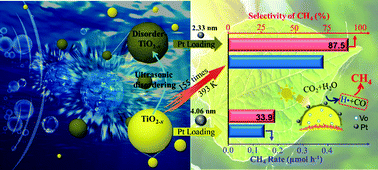Our official English website, www.x-mol.net, welcomes your
feedback! (Note: you will need to create a separate account there.)
Revisiting Pt/TiO2 photocatalysts for thermally assisted photocatalytic reduction of CO2.
Nanoscale ( IF 5.8 ) Pub Date : 2020/02/11 , DOI: 10.1039/c9nr09743k Fei Yu 1 , Changhua Wang , He Ma , Miao Song , Dongsheng Li , Yingying Li , Songmei Li , Xintong Zhang , Yichun Liu
Nanoscale ( IF 5.8 ) Pub Date : 2020/02/11 , DOI: 10.1039/c9nr09743k Fei Yu 1 , Changhua Wang , He Ma , Miao Song , Dongsheng Li , Yingying Li , Songmei Li , Xintong Zhang , Yichun Liu
Affiliation

|
Artificial photosynthesis by a semiconductor-oxide-based photocatalysis is presently challenging due to low CO2 conversion rates and poor product selectivity. To promote CO2 reduction, Pt/TiO2 has been deemed as a classic photocatalyst. In this study, we restudy Pt/TiO2 for the thermally assisted photocatalytic reduction of CO2 and reveal a different story between photocatalysis and photothermal catalysis. For example, when using disordered Pt/TiO2-x, the CO2 conversion via photocatalysis at 298 K is not impressive. However, when the system temperature is increased to 393 K, the CO2 conversion rate is significantly enhanced by a factor of 155 as compared to that obtainable from pristine TiO2; further, surprisingly high selectivity of CH4 (87.5%) could be achieved. Thermally coupled photocatalysis yields the enhanced evolution of H2 side products over Pt (4.06 nm)/TiO2 and promoted H2 splitting over Pt (2.33 nm)/TiO2, which is seldom observed in conventional Pt/TiO2 photocatalysis. The synergy of improved charge separation at the Pt/TiO2-x interface induced by surface disordering and accelerated H2 consumption near smaller Pt nanoparticles by thermal assistance are believed to be critically important for the simultaneous enhancement of CO2 conversion rates and CH4 product selectivity. This study inspires revisiting not only Pt/TiO2 but also reactivating other semiconductor-oxide-based photocatalysts for use in thermally assisted photocatalysis.
中文翻译:

回顾Pt / TiO2光催化剂,以热辅助光催化还原CO2。
由于低的CO 2转化率和较差的产物选择性,目前基于半导体氧化物的光催化进行人工光合作用具有挑战性。为了促进二氧化碳的还原,Pt / TiO2被认为是经典的光催化剂。在本研究中,我们对Pt / TiO2进行了热辅助光催化还原CO2的再研究,并揭示了光催化与光热催化之间的不同故事。例如,当使用无序Pt / TiO2-x时,在298 K下通过光催化进行的CO2转化率不高。但是,当系统温度升至393 K时,与原始TiO2相比,CO2转化率显着提高了155倍。此外,可以实现令人惊讶的高选择性的CH4(87.5%)。热耦合光催化产生的H2副产物在Pt(4.06 nm)/ TiO2上增强了析出,并在Pt(2.33 nm)/ TiO2上促进了H2分裂,这在常规Pt / TiO2光催化中很少观察到。据信,由表面无序引起的Pt / TiO2-x界面电荷分离改善和通过热辅助在较小的Pt纳米颗粒附近加速H2消耗的协同作用对于同时提高CO2转化率和CH4产物选择性至关重要。这项研究不仅激发了对Pt / TiO2的研究,而且还激发了其他用于热辅助光催化的基于半导体氧化物的光催化剂的再活化。据信,由表面无序引起的Pt / TiO2-x界面电荷分离改善和通过热辅助在较小的Pt纳米颗粒附近加速H2消耗的协同作用对于同时提高CO2转化率和CH4产物选择性至关重要。这项研究不仅激发了对Pt / TiO2的研究,而且还激发了其他用于热辅助光催化的基于半导体氧化物的光催化剂的再活化。据信,由表面无序引起的Pt / TiO2-x界面电荷分离改善和通过热辅助在较小的Pt纳米颗粒附近加速H2消耗的协同作用对于同时提高CO2转化率和CH4产物选择性至关重要。这项研究不仅激发了对Pt / TiO2的研究,而且还激发了其他用于热辅助光催化的基于半导体氧化物的光催化剂的再活化。
更新日期:2020-04-03
中文翻译:

回顾Pt / TiO2光催化剂,以热辅助光催化还原CO2。
由于低的CO 2转化率和较差的产物选择性,目前基于半导体氧化物的光催化进行人工光合作用具有挑战性。为了促进二氧化碳的还原,Pt / TiO2被认为是经典的光催化剂。在本研究中,我们对Pt / TiO2进行了热辅助光催化还原CO2的再研究,并揭示了光催化与光热催化之间的不同故事。例如,当使用无序Pt / TiO2-x时,在298 K下通过光催化进行的CO2转化率不高。但是,当系统温度升至393 K时,与原始TiO2相比,CO2转化率显着提高了155倍。此外,可以实现令人惊讶的高选择性的CH4(87.5%)。热耦合光催化产生的H2副产物在Pt(4.06 nm)/ TiO2上增强了析出,并在Pt(2.33 nm)/ TiO2上促进了H2分裂,这在常规Pt / TiO2光催化中很少观察到。据信,由表面无序引起的Pt / TiO2-x界面电荷分离改善和通过热辅助在较小的Pt纳米颗粒附近加速H2消耗的协同作用对于同时提高CO2转化率和CH4产物选择性至关重要。这项研究不仅激发了对Pt / TiO2的研究,而且还激发了其他用于热辅助光催化的基于半导体氧化物的光催化剂的再活化。据信,由表面无序引起的Pt / TiO2-x界面电荷分离改善和通过热辅助在较小的Pt纳米颗粒附近加速H2消耗的协同作用对于同时提高CO2转化率和CH4产物选择性至关重要。这项研究不仅激发了对Pt / TiO2的研究,而且还激发了其他用于热辅助光催化的基于半导体氧化物的光催化剂的再活化。据信,由表面无序引起的Pt / TiO2-x界面电荷分离改善和通过热辅助在较小的Pt纳米颗粒附近加速H2消耗的协同作用对于同时提高CO2转化率和CH4产物选择性至关重要。这项研究不仅激发了对Pt / TiO2的研究,而且还激发了其他用于热辅助光催化的基于半导体氧化物的光催化剂的再活化。









































 京公网安备 11010802027423号
京公网安备 11010802027423号